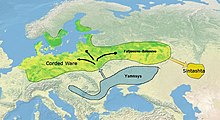
Back هندو إيرانيون Arabic Индо-ирански народи Bulgarian ইন্দো-ইরানি Bengali/Bangla ھیندۆ ئێرانییەکان CKB Indoíránci Czech Pueblos indoiranios Spanish مردمان هندوایرانی Persian Indoiranilaiset kulttuurit Finnish Indo-Iraniens French Indoiranski narodi Croatian


| Part of a series on |
| Indo-European topics |
|---|
 |
The Indo-Iranian peoples,[10][11][12] also known as Ā́rya or Aryans from their self-designation, were a group of Indo-European speaking peoples who brought the Indo-Iranian languages to major parts of Eurasia in waves from the first part of the 2nd millennium BC onwards. They eventually branched out into the Iranian peoples and Indo-Aryan peoples.
- ^ Allentoft, Morten E.; Sikora, Martin; Sjögren, Karl-Göran; Rasmussen, Simon; Rasmussen, Morten; Stenderup, Jesper; Damgaard, Peter B.; Schroeder, Hannes; Ahlström, Torbjörn; Vinner, Lasse; Malaspinas, Anna-Sapfo; Margaryan, Ashot; Higham, Tom; Chivall, David; Lynnerup, Niels (2015-06-11). "Population genomics of Bronze Age Eurasia". Nature. 522 (7555): 167–172. Bibcode:2015Natur.522..167A. doi:10.1038/nature14507. ISSN 0028-0836. PMID 26062507.
- ^ Mathieson, Iain; Lazaridis, Iosif; Rohland, Nadin; Mallick, Swapan; Patterson, Nick; Roodenberg, Songül Alpaslan; Harney, Eadaoin; Stewardson, Kristin; Fernandes, Daniel; Novak, Mario; Sirak, Kendra; Gamba, Cristina; Jones, Eppie R.; Llamas, Bastien; Dryomov, Stanislav (2015-12-24). "Genome-wide patterns of selection in 230 ancient Eurasians". Nature. 528 (7583): 499–503. Bibcode:2015Natur.528..499M. doi:10.1038/nature16152. ISSN 0028-0836. PMC 4918750. PMID 26595274.
- ^ Narasimhan, Vagheesh M.; Patterson, Nick; Moorjani, Priya; Lazaridis, Iosif; Lipson, Mark; Mallick, Swapan; Rohland, Nadin; Bernardos, Rebecca; Kim, Alexander M. (2018-03-31). The Genomic Formation of South and Central Asia (Report). Genomics. doi:10.1101/292581. hdl:21.11116/0000-0001-E7B3-0.
- ^ Chintalapati, Manjusha; Patterson, Nick; Moorjani, Priya (2022-05-30). "The spatiotemporal patterns of major human admixture events during the European Holocene". eLife. 11. doi:10.7554/eLife.77625. ISSN 2050-084X. PMC 9293011. PMID 35635751.
- ^ Anthony 2007, pp. 380–383.
- ^ Kuzʹmina, E. E.; Mallory, J. P. (2007). The Origin of the Indo-Iranians. Leiden Indo-European etymological dictionary series. Leiden, The Netherlands ; Boston: Brill. p. 302. ISBN 978-90-04-16054-5. OCLC 154946049.
- ^ Mallory, J. P.; Adams, Douglas Q., eds. (1997). Encyclopedia of Indo-European culture. London ; Chicago: Fitzroy Dearborn. p. 2. ISBN 978-1-884964-98-5.
- ^ Pamjav H, Feher T, Nemeth E, Padar Z (2012). "Brief communication: new Y-chromosome binary markers improve phylogenetic resolution within haplogroup R1a1". American Journal of Physical Anthropology. 149 (4): 611–615. doi:10.1002/ajpa.22167. PMID 23115110. "However, with the discovery of the Z280 and Z93 substitutions within Phase 1 1000 Genomes Project data and subsequent genotyping of these SNPs in ∼200 samples, a schism between European and Asian R1a chromosomes has emerged"
- ^ Kristiansen, Kristian; Kroonen, Guus; Willerslev, Eske (11 May 2023). The Indo-European Puzzle Revisited: Integrating Archaeology, Genetics, and Linguistics. Cambridge University Press. pp. 70–71. ISBN 978-1-009-26174-6. "How exactly the emergence and expansion of the Corded Ware are linked to the emergence and expansion of the Yamnaya horizon remains unclear. However, the Y chromosome record of both groups indicates that Corded Ware cannot be derived directly from the Yamnaya or late eastern farming groups sampled thus far, and is therefore likely to constitute a parallel development in the forest steppe and temperate forest zones of Eastern Europe. Even in Central Europe, the formation of the earliest regional Corded Ware identities was the result of local and regional social practices that resulted in the typical Corded Ware rite of passage."
- ^ Chen, Sanping. "SOME REMARKS ON THE CHINESE" BULGAR"." Acta Orientalia Academiae Scientiarum Hungaricae (1998): 69–83.
- ^ Motti, Victor Vahidi. "Richard Slaughter: The master interpreter of alternative planetary futures." Futures 132 (2021): 102796.
- ^ Dwyer, Arienne M. "The texture of tongues: Languages and power in China." Nationalism and ethnoregional identities in China. Routledge, 2013. 68–85.
Cite error: There are <ref group=note> tags on this page, but the references will not show without a {{reflist|group=note}} template (see the help page).
© MMXXIII Rich X Search. We shall prevail. All rights reserved. Rich X Search